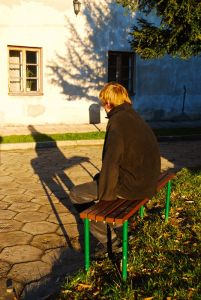Polycystic Kidney Disease (PKD) is considered to be one of the most fatal genetic diseases that affects more then 500,000 people in the United States. This disease, caused by a mutation in certain genes, causes the growth of cysts on the kidneys, which lead to kidney enlargement and failure. The are currently no treatments to permanently cure or halt the progression of this disease. Current solutions for PKD are receiving either a kidney transplant or staying on dialysis for the rest of ones life, neither of which are ideal situations.
Read MoreTags: CA, new research funding, Southwest, University of California Santa Barbara, 2015, UCSB, Santa Barbara, kidney disease, Polycystic Kidney Disease
 Stuttering is a potentially embarrassing, yet somewhat common affliction that affects nearly one percent of people worldwide. Characterized as a speech pattern in which people stumble, sputter and “trip over their tongue”, stuttering is one step closer to being understood thanks to researchers at UCSB.
Stuttering is a potentially embarrassing, yet somewhat common affliction that affects nearly one percent of people worldwide. Characterized as a speech pattern in which people stumble, sputter and “trip over their tongue”, stuttering is one step closer to being understood thanks to researchers at UCSB.
Tags: CA, Neurobiology, 2015, BioResearch Product Faire Front Line Event, Neurology, UCSB, Santa Barbara, university bioresearch, UC Santa Barbara
 Important things are on the horizon for scientists at UCSB.
Important things are on the horizon for scientists at UCSB.
Several researchers at the University of California, Santa Barbara will take part in the newly funded UC-wide Institute for the Study of Ecological and Evolutionary Climate Impacts (ISEECI). Biology professor Barry Sinervo from UC Santa Cruz is heading the initiative, which was awarded $1.9 million in 2014 as part of the UC President’s Research Catalyst Award.
Read MoreTags: CA, California, 2015, BioResearch Product Faire Front Line Event, Research Funding, UCSB, Santa Barbara, UC Santa Barbara
When someone gets an open wound or injury, one of the first things the body does is try to stop the flow of blood. The body does this by forming clots that turn the blood from liquid to gel to plug the wound and stop the body from bleeding out. If this clotting doesn't happen right away, it makes further treatment and healing of the wound more difficult or impossible. To help with the clotting process, researchers at the University of California, Santa Barbara have created nanoparticles that resemble blood platelets that can be used to speed up the healing process and create clots faster to decrease blood loss from an injury.
Read MoreTags: CA, Southwest, 2015, BioResearch Product Faire Event, UCSB, Santa Barbara
 Sepsis, the leading cause of death in hospitals throughout the United States, is caused when someone has a severe reaction to germs and bacteria. It often occurs as a complication to an infection or a surgery, when the immune system has been weakened and is unable to fight off bacteria. Considering how frequently sepsis occurs, it is surprising how under-represented it is in health talks and research. One researcher at the University of California Santa Barbara was recently awarded a $3.5 million grant from the NIH Heart, Lung and Blood Institute to continue his work on increasing sepsis survival rates. (Image on right courtesy of Wikimedia).
Sepsis, the leading cause of death in hospitals throughout the United States, is caused when someone has a severe reaction to germs and bacteria. It often occurs as a complication to an infection or a surgery, when the immune system has been weakened and is unable to fight off bacteria. Considering how frequently sepsis occurs, it is surprising how under-represented it is in health talks and research. One researcher at the University of California Santa Barbara was recently awarded a $3.5 million grant from the NIH Heart, Lung and Blood Institute to continue his work on increasing sepsis survival rates. (Image on right courtesy of Wikimedia).
Tags: CA, Southwest, 2015, BioResearch Product Faire Event, UCSB, Santa Barbara, UC Santa Barbara
Researchers at the University of California, Santa Barbara recently conducted a study on fruit flies that shows that diet experience can alter taste preference. This finding has been speculated about before, but its implications now are important because taste preference is essential for survival when animals and humans are forced to respond to changing sources of food. The researchers exposed fruit flies to camphor, which the fruit flies disliked, and which caused a reduction in the response by the Transient Receptor Potential-Like (TRPL) channel. The degredation of the TRPL protein by an enzyme called E3 ubiquitin ligase, or Ube3a, caused a reduction in the fruit flie’s distaste for camphor.
Tags: 2014, CA, Life Science Funding, California, University of California Santa Barbara, BioResearch Product Faire Event, Research Funding, UCSB, Santa Barbara
Researchers are invited to UCSB BioResearch Product Faire. There’s no better way to learn about the latest lab technologies on the market and socialize with colleagues at the University of California, Santa Barbara than to attend Biotechnology Calendar, Inc.’s upcoming Santa Barbara life science event on April 1st, 2014. At the Santa Barbara BioResearch Product Faire™ Event, you will have the opportunity to meet other researchers and lab supply sales reps interested in hearing about your research processes. Biotechnology Calendar, Inc. events bring high quality vendors to your doorstep and helps you find products that meet your research needs.
Tags: 2014, CA, California, University of California Santa Barbara, BioResearch Product Faire Event, UCSB, Santa Barbara, researcher invite, researchers invited
Researchers at the University of California, Santa Barbara have discovered the age and origin of an E280A gene mutation that has caused early-onset Alzheimer’s in a Columbian family. The family, whose members have had Alzheimer’s with more frequency than most families, was traced to a single founder dating from the 1500’s. The research team sequenced the genomes of more than 100 family members and identified the regions of common ancestry. They then used this information to trace the source of the Alzheimer’s mutation.
Tags: 2014, CA, 2013, Southwest, BioResearch Product Faire Front Line Event, BioResearch Product Faire Event, UCSB, Santa Barbara, Alzheimer's research market, Alzheimer's treatment market, UC Santa Barbara
The National Eye Institute, an NIH agency dedicated to vision research, recently announced the winners of their Challenge to Identify Audacious Goals in Vision Research and Blindness Rehabilitation, or the Audacious Goals Challenge for short. The competition was open to professionals and members of the public and called upon them to think big and bold about vision research goals for the next decades. The prize money was nominal ($3,000) but included an invitation and travel money to attend and present their ideas at the NEI Audacious Goals Development Meeting in Maryland later this month. The real prize, of course, was the opportunity to help set research and funding goals for the next 10-12 years. Of the 500 or so proposals submitted, 10 visionaries were selected as winners.
Tags: University of Michigan, 2014, CA, Harvard University, Midwest, 2013, Northeast, university of utah, Washington University, Missouri, WashU, UUtah, St. Louis Bioresearch Product Faire Event, Oregon Health and Science University, Northwest, crowdsourcing, Vision Sciences Research, National Eye Institute (NEI), Blindness Rehabilitation, Southwest, University of Alabama, Southern, UT, Ann Arbor, Boston, BioResearch Product Faire Event, Funding, MI, MA, NIH, Harvard, OR, Salt Lake City, Birmingham, AL, UCSB, Santa Barbara, OHSU, Portland, UMich, UC Santa Barbara, Rehabilitation
 Yesterday we looked at two biologically inspired engineering experiments out of the Wyss Institute in Boston. Today we're on the West Coast at the University of California Santa Barbara's Institute for Collaborative Biotechnologies (ICB) marvelling over another technology that takes its cue from the biological world. It's a microfluidics device designed to function much like the super-sensitive nose of a dog, and it's already being commercialized for use in bomb detection, though other applications could include bio/chemical detection in industrial and healthcare settings as well. Results of the research gauging bomb detection accuracy specifically were published recently in an article in the journal Analytical Chemistry.
Yesterday we looked at two biologically inspired engineering experiments out of the Wyss Institute in Boston. Today we're on the West Coast at the University of California Santa Barbara's Institute for Collaborative Biotechnologies (ICB) marvelling over another technology that takes its cue from the biological world. It's a microfluidics device designed to function much like the super-sensitive nose of a dog, and it's already being commercialized for use in bomb detection, though other applications could include bio/chemical detection in industrial and healthcare settings as well. Results of the research gauging bomb detection accuracy specifically were published recently in an article in the journal Analytical Chemistry.
Tags: CA, Lab-on-a-chip Technology, Southwest, California, 2012, University of California Santa Barbara, Biotechnology, Front Line event, UCSB, Santa Barbara

